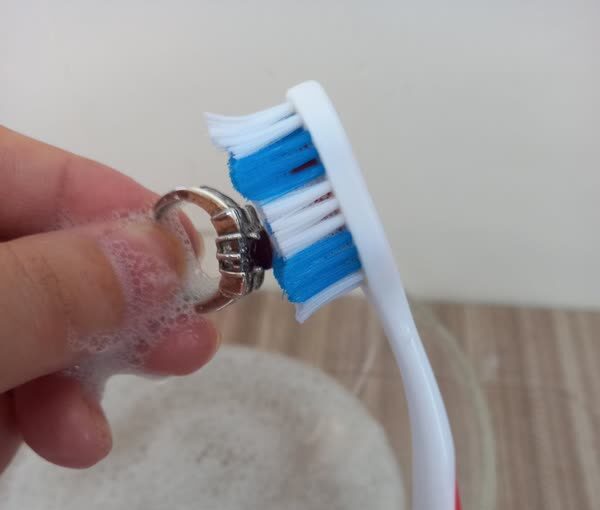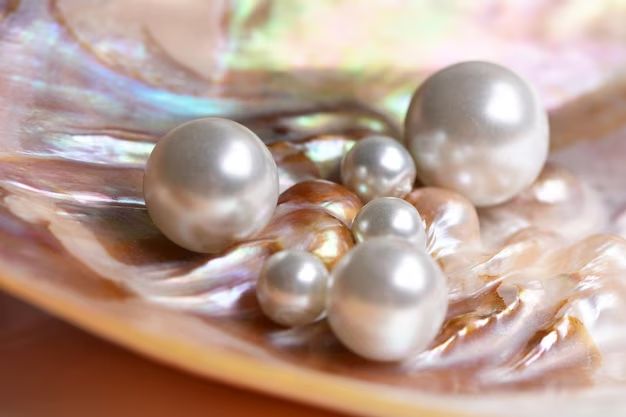
- Jewelry
Comprehensive Jewelry Care Guide
Table of Contents
How to Clean Gold Jewelry
These are general guidelines for cleaning gold, platinum, and gemstone jewelry. However, it's important to note that specific gemstones may require specialized care. Always consult a jeweler for advice on delicate or valuable pieces.
Gold jewelry, while durable, can accumulate dirt and oils over time, dulling its luster. Here's a simple method to restore its shine:
Materials:
• Warm water
• Mild dish soap
• Soft-bristled toothbrush
• Soft, lint-free cloth
Steps:
1. Prepare the cleaning solution: Fill a small bowl with warm water and a few drops of mild dish soap.
2. Soak the jewelry: Gently place your gold jewelry in the soapy water and let it soak for about 15 minutes.
3. Gentle scrubbing: Use a soft-bristled toothbrush to gently scrub away any dirt or grime, paying attention to crevices and intricate details.
4. Rinse thoroughly: Rinse the jewelry under warm water to remove all soap residue.
5. Dry gently: Pat the jewelry dry with a soft, lint-free cloth. Avoid rubbing vigorously to prevent scratches.





Important tips:
• Avoid harsh chemicals: Strong chemicals like chlorine and bleach can damage gold.
• Inspect gemstones: If your gold jewelry has gemstones, handle it with extra care. Some gemstones are more delicate than others.
• Regular cleaning: Clean your gold jewelry regularly to prevent buildup and maintain its shine.
• For severely tarnished gold or jewelry with intricate designs, consider professional cleaning. Platinum and silver jewelry share many of the same care requirements as gold jewelry. They benefit from similar cleaning methods and protective measures. However, it's essential to note that silver is more prone to tarnish compared to gold and platinum.
• Both platinum and silver jewelry can be cleaned using warm water, mild dish soap, and a soft-bristled toothbrush. Regular cleaning and proper storage in a soft, lined jewelry box are recommended for both metals.
Keep Your Gems Gleaming
Gemstones, nature's exquisite creations, demand special care to preserve their brilliance and longevity. Over time, these precious stones can accumulate dirt, oils, and other residues, diminishing their sparkle. Proper cleaning and protection are essential to maintain the beauty of your gemstone jewelry. This guide will provide valuable tips on how to care for your treasured pieces, ensuring they continue to captivate for years to come.
Gemstones are diverse in their composition, and as such, require tailored care. Each gemstone possesses unique properties that dictate the best methods for cleaning and protection. From the delicate opal to the resilient diamond, understanding these differences is crucial in preserving the beauty and longevity of your gemstone jewelry.
How to Clean Diamond Jewelry?
Diamonds are renowned for their brilliance, but they can accumulate dirt and oil over time, diminishing their sparkle. Here’s a simple method to restore your diamond jewelry's luster:
Cleaning diamonds is similar to cleaning other types of jewelry. A gentle cleaning method involving warm water and mild dish soap is often effective. However, diamonds are exceptionally hard, making them more resistant to damage compared to softer gemstones. keep in mind regular cleaning helps maintain the diamond’s brilliance.
Can we Use Chemicals, Ultrasonic Cleaners, or Steam Cleaners for Diamonds?
Yes, you can generally use chemicals, ultrasonic cleaners, and steam cleaners on diamonds.
• Chemicals: Mild jewelry cleaning solutions are safe for diamonds. Avoid harsh chemicals like bleach or ammonia.
• Ultrasonic cleaners: These are effective for removing dirt and grime from diamonds. However, be cautious with delicate settings, as the vibrations may loosen them.
• Steam cleaners: Can be used on diamonds, but exercise caution to avoid overheating the stone.
Always check the specific cleaning solution for compatibility with diamonds and follow the instructions carefully and inspect your jewelry after cleaning to ensure the setting is secure.
Avoid harsh chemicals: These can damage the metal setting.
• Inspect the setting: Check for loose prongs or damage.
• Ultrasonic cleaners and steam cleaners: Generally safe for diamonds but use caution with delicate settings.
By following these guidelines, you can keep your diamond jewelry sparkling.
How to protect ruby jewelry?
To keep your ruby jewelry looking its best, follow these protection and cleaning tips:
Protection tips:
1. Avoid Physical Impact:
Rubies are hard but can still chip or crack. Avoid wearing your ruby jewelry during activities that might cause impact.
2. Keep Away from Chemicals:
Chemicals in household cleaners, perfumes, and cosmetics can damage rubies. Put on your jewelry after applying makeup and perfume.
3. Proper Storage:
Store your ruby pieces separately in a soft pouch or lined jewelry box to prevent scratching and tangling with other jewelry.
4. Regular Inspections:
Check for loose settings or prongs. Have a professional jeweler inspect your pieces regularly.
Cleaning tips:
1. Gentle Cleaning:
Mix a small amount of mild dish soap with lukewarm water. Use a soft-bristled toothbrush to gently scrub the ruby and the setting.
2. Rinse and Dry:
Rinse thoroughly with lukewarm water to remove any soap residue. Pat dry with a soft, lint-free cloth.
3. Ultrasonic Cleaners:
Rubies can usually be cleaned in ultrasonic cleaners, but avoid this if the ruby has any fractures or is heavily included. Consult a jeweler if unsure.
4. Avoid Harsh Methods:
Do not use steam cleaners or boiling water, as extreme temperatures can damage rubies.
5. Professional Cleaning:
For a thorough clean, take your ruby jewelry to a professional jeweler periodically. They have the tools and expertise to clean and polish your pieces safely.
By following these guidelines, you can maintain the beauty and integrity of your ruby jewelry for years to come.
How to protect emerald jewelry?
To clean and protect your emerald jewelry effectively, follow these guidelines for maintenance and care. Emeralds require special care due to their unique properties. Here’s a step-by-step method to clean your emerald jewelry safely:
1. Prepare a Cleaning Solution:
Mix a few drops of mild dish soap (like Dawn) in a bowl of lukewarm water. Avoid using hot water, as it can damage the oils and resins used in many emeralds.
2. Soak Briefly:
Submerge the jewelry in the soapy water for about one minute. Do not soak for longer, as prolonged exposure can lead to damage.
3. Gentle Scrubbing:
Using a soft-bristled toothbrush, gently scrub the emerald and its setting. Focus on hard-to-reach areas but avoid scrubbing directly on the surface of the emerald to prevent scratches.
4. Rinse Thoroughly:
Rinse the jewelry under lukewarm running water to remove any soap residue. Be cautious to prevent it from slipping down the drain; using a sink stopper can help.
5. Dry Carefully:
Pat the jewelry dry with a soft microfiber cloth or allow it to air dry. Avoid using paper towels, which can scratch the surface.
Important Tips
-Avoid Harsh Chemicals: Do not use ultrasonic cleaners, steam cleaners, or any cleaning solutions containing alcohol, acetone, or petroleum distillates, as these can damage the emeralds and their treatments.
- Frequency of Cleaning: You don't need to clean your emerald jewelry after every wear. A few times a year is sufficient, depending on how often you wear it.
- Protecting Emerald Jewelry: To ensure the longevity and beauty of your emeralds, consider the following protective measures:
-Storage: Store emerald jewelry separately from harder gemstones like diamonds and sapphires to prevent scratching. Use a soft pouch or a dedicated jewelry box.
- Avoid Extreme Conditions: Keep emeralds away from extreme temperatures, direct sunlight, and hot lights, which can dry out oils and resins used in treatments.
- Limit Exposure: Remove emerald jewelry when engaging in activities that may expose it to harsh conditions, such as exercising, gardening, or cleaning with chemicals.
- Regular Inspections: Periodically check your jewelry to ensure that the stones are secure in their settings. Have any loose stones tightened by a professional jeweler.
By following these cleaning and protection tips, you can maintain the beauty and integrity of your emerald jewelry for years to come.
How to protect and clean sapphire jewelry?
To maintain the beauty and integrity of your sapphire jewelry, follow these protection and cleaning tips:
Protection Tips
1. Avoid Physical Impact:
Sapphires are durable but can still be chipped or scratched by harder materials. Avoid wearing your sapphire jewelry during activities that could cause impact or abrasion.
2. Keep Away from Chemicals:
Chemicals found in household cleaners, perfumes, and cosmetics can damage sapphires. Apply makeup, perfume, and hairspray before putting on your jewelry.
3. Proper Storage:
Store sapphire jewelry separately in a soft pouch or a lined jewelry box to prevent scratching and tangling with other pieces.
4. Regular Inspections:
Inspect your sapphire jewelry regularly for loose settings or prongs. Have a professional jeweler check and repair any issues to prevent stone loss.
Cleaning Tips
1. Gentle Cleaning:
Use a mixture of mild dish soap and lukewarm water. Soak the jewelry for a few minutes, then use a soft-bristled toothbrush to gently scrub the sapphire and the setting.
2. Rinse and Dry:
Rinse thoroughly with lukewarm water to remove all soap residues. Dry with a soft, lint-free cloth to avoid water spots.
3. Ultrasonic Cleaners:
Sapphires can generally be cleaned in ultrasonic cleaners, but avoid this if the stone has fractures or extensive inclusions. If unsure, consult a jeweler.
4. Avoid Harsh Methods:
Do not use steam cleaners or subject sapphires to sudden temperature changes, as extreme heat can damage them.
5. Professional Cleaning:
For a more thorough cleaning, take your sapphire jewelry to a professional jeweler periodically. They can clean and polish your pieces using specialized tools and techniques.
By adhering to these protection and cleaning practices, you can ensure your sapphire jewelry remains stunning and well-preserved for many years.
How to protect and clean opal jewelry?
Opal jewelry requires special care due to the stone's unique properties. Here are some guidelines to protect and clean your opal jewelry:
Protection Tip
1. Avoid Exposure to Heat and Dryness:
- Opals contain water and can crack or craze if exposed to extreme temperatures or dry conditions. Avoid wearing opal jewelry in situations where it might be exposed to such environments.
2. Avoid Chemicals:
- Chemicals found in household cleaners, perfumes, cosmetics, and hairsprays can damage opals. Apply these products before putting on your opal jewelry.
3. Proper Storage:
- Store opal jewelry separately in a soft pouch or a lined jewelry box to prevent scratching. Avoid storing opals in airtight containers or places with low humidity.
4. Handle with Care:
- Opals are relatively soft and can be scratched or chipped easily. Handle your opal jewelry gently and avoid wearing it during activities that might cause impact or abrasion.
5. Moisture Maintenance:
- To prevent dehydration, store your opals in a location with some humidity. A small container with a damp cloth or cotton ball in your jewelry box can help maintain moisture levels.
Cleaning Tips
1. Gentle Cleaning:
- Wipe opals with a soft, damp cloth after each wear to remove any dirt or oils. This helps maintain their luster.
2. Mild Soap Solution:
- For occasional deeper cleaning, use a small amount of mild soap (not detergent) mixed with lukewarm water. Dampen a soft cloth with the solution and gently wipe the opal. Avoid soaking the opal in water, especially doublets or triplets, as the layers can separate.
3. Rinse and Dry:
- After cleaning, wipe the opal with a cloth dampened with clean water to remove any soap residue. Pat dry with a soft, lint-free cloth.
4. Avoid Harsh Cleaners:
- Do not use ultrasonic cleaners, steam cleaners, or abrasive materials to clean opals, as they can damage the stone.
5. Professional Cleaning:
- For a thorough cleaning, take your opal jewelry to a professional jeweler periodically. They have the expertise to clean and care for opals safely.
By following these protection and cleaning tips, you can maintain the beauty and longevity of your opal jewelry.
How to Protect Organic Jewelries like Amber, Pearl, Coral, and Jet?
Organic gemstones, like amber, pearl, coral, and jet, are delicate and require special care to maintain their beauty and longevity.
General Care Tips
• Avoid harsh chemicals: These can damage the organic material.
• Store carefully: Keep your jewelry in a soft, lined box or pouch to prevent scratches.
• Handle with care: Avoid excessive handling, as oils from your skin can dull the luster.
• Protect from extreme temperatures: Heat and cold can damage these gemstones.
• Keep away from moisture: Excessive moisture can damage some organic gemstones, especially pearls and coral.
Specific Care for Each Gemstone
• Amber: Avoid heat and direct sunlight, as it can cause discoloration. Clean gently with a soft cloth.
• Pearl: Store pearls away from other jewelry to prevent scratches. Clean with a damp cloth or use a specialized pearl cleaning solution.
• Coral: Avoid contact with perfumes, lotions, and harsh chemicals. Clean with a soft cloth dampened with warm water.
• Jet: Protect from heat and direct sunlight. Clean gently with a soft cloth.
Some protection and cleaning up advices for other gemstones:
Amethyst
• Protection: Amethyst can fade with prolonged exposure to direct sunlight. Avoid contact with chemicals.
• Cleaning: Clean with mild soap and water. Avoid steam and ultrasonic cleaners.
Topaz
• Protection: Topaz can be prone to scratches and chips. Avoid sudden temperature changes and chemicals.
• Cleaning: Use warm, soapy water and a soft brush. Avoid steam and ultrasonic cleaners.
Garnet
• Protection: Garnet is relatively hard but can still be scratched by harder materials.
• Cleaning: Clean with warm, soapy water and a soft brush. Avoid harsh chemicals.
Turquoise
• Protection: Turquoise is soft and porous, making it susceptible to scratches, chemicals, and moisture.
• Cleaning: Wipe with a damp cloth. Avoid soaking and exposure to chemicals.
peridot
• Protection: Peridot is softer than many gemstones and can scratch easily.
• Cleaning: Use warm, soapy water and a soft brush. Avoid steam and ultrasonic cleaners.
Aquamarine
• Protection: Aquamarine is fairly durable but can chip with impact.
• Cleaning: Use warm, soapy water and a soft brush. Avoid steam cleaners if the stone has inclusions.
Tanzanite
• Protection: Tanzanite is relatively soft and should be protected from scratches and impacts.
Proper care is essential to preserve the beauty and longevity of your jewelry.
what is ultrasonic cleaner for jewlry?
An ultrasonic cleaner is a device that uses high-frequency sound waves to clean objects.
When it comes to jewelry, these sound waves create tiny bubbles in the cleaning solution that effectively remove dirt, grime, and oils from the jewelry's surface, even in hard-to-reach areas.
How it works:
• The cleaner contains a tank filled with a cleaning solution (usually water with a mild detergent).
• Ultrasonic transducers generate high-frequency sound waves within the solution.
• These sound waves create microscopic bubbles that implode, producing shock waves.
• The shock waves agitate the cleaning solution and remove dirt and debris from the jewelry.
Benefits of using an ultrasonic cleaner:
• Effective at removing dirt and grime from intricate designs.
• Faster and more efficient than manual cleaning methods.
• Can be used for various types of jewelry (although not all).
Important note: While ultrasonic cleaners are effective for many types of jewelry, they are not suitable for all gemstones. Some delicate stones, like opals and pearls, can be damaged by the vibrations.
what is steam cleaner for jewelry?
A steam cleaner for jewelry uses high-pressure steam to remove dirt, grime, and oils from jewelry. The intense heat of the steam helps to loosen and dissolve debris, leaving your jewelry sparkling clean.
Key benefits of using a steam cleaner:
• Effective: Removes dirt and grime from intricate designs.
• Safe: Doesn't require harsh chemicals.
• Quick: Provides a fast cleaning process.
Important note: While steam cleaning is safe for many types of jewelry, it's crucial to check the suitability for specific gemstones. Some delicate stones, like opals and pearls, can be damaged by the heat
In conclusion while gold, platinum, and silver share similar cleaning methods, gemstones demand specialized attention due to their diverse properties. From the resilient diamond to the delicate opal, each gemstone requires specific care to maintain its brilliance. By understanding the unique needs of your jewelry and following the guidelines outlined in this guide, you can ensure your treasured pieces continue to shine for generations to come. Remember, for intricate or valuable items, consulting a professional jeweler is always recommended.
Related Posts
Fall in Love with Jewelry, Stories, and Secrets
Join Artemies Magazine for insider jewelry tips, trend updates, and subscriber-only discounts.



